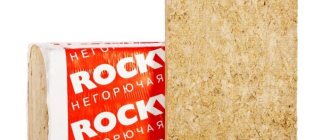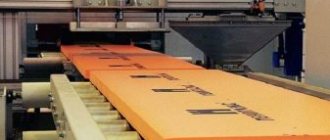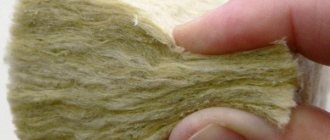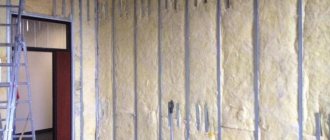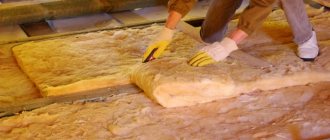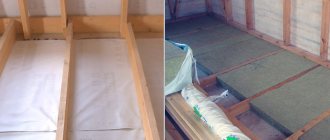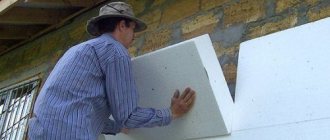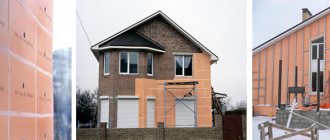general information
Mineral wool is a fibrous material obtained from metal slag or molten rock.
Mineral wool has been used for effective wall insulation for decades, but now manufacturers produce much better products than before. The harmfulness of the material to the environment and the human body has been reduced, and its thermal insulation properties have been increased.
There are several subtypes of mineral wool for wall insulation, and we will now consider them.
Types of mineral wool
Any type of this insulation has fibers. These fibers are formed during the cooling of crushed minerals, which are then pulled into long thin threads. The material is classified based on the initial raw materials:
- Stone. Made from granite, basalt or porphyrite. Insulating walls with basalt mineral wool is best suited for buildings that must be in perfect condition for many decades. This mineral wool has the highest strength.
- Slag. It is based on waste from the metallurgical industry. The quality of this product is lower than that of the previous subspecies. Slag mineral wool for wall insulation does not tolerate sudden temperature changes. Typically used as an inexpensive option for use in sheds or summer buildings.
- Glass. It is made from molten glass, to which limestone, dolomite and soda are added. The most elastic option, well resistant to vibration. Suitable for buildings where fire safety is especially important.
Insulating walls from the inside with any mineral wool requires analysis - which option is suitable in a particular case. Having decided on the type of material, we move on to its form.
Why are calculations needed?
It would be very convenient if the mineral wool insulation and the thickness of this insulation had a standard value. Unfortunately, there are not even any approximate values. The calculation is performed based on individual project data. And it is very important not to make a mistake. After all, if you lay mineral wool in a layer that is thinner than necessary, you will not achieve the desired effect. The walls of the house will freeze, and moisture will begin to accumulate inside the facades. And there it won’t be long before mold and mildew forms.
Conversely, when laying in a layer thicker than necessary, you will spend money on an absolutely unnecessary amount of insulation.
Sizes and shape of mineral wool
Stone wool for wall insulation, like any other, is produced in two formats - roll and slab.
Rolled wool consists of long strips of material. The length is from 7 to 10 meters, and the width is a maximum of 120 cm. Thickness is 0.5 cm. These parameters make it easy to transport mineral wool and attach it to the wall. Cotton wool in rolls is usually sold of lower quality and, accordingly, at a lower cost.
Insulating walls with stone mineral wool in the form of slabs is even easier. The slabs are designed specifically for smooth vertical surfaces. Typically, the size of each unit is 120 cm in length and 100 cm in width. Thickness from 3 cm (for floors) to 10 cm (for roofs). Laying such slabs is very easy; you don’t have to hire a professional for this.

Advantages and disadvantages
The advantages of insulating walls with mineral wool include the following factors:
- the material absorbs sounds well;
- low flammability;
- metal products do not rust when in contact with insulation;
- thermal stability, no deformation even with temperature fluctuations;
- easy processing (cutting, sawing).
There are also disadvantages:
- low vapor permeability, due to which condensation often appears - it is recommended to attach a membrane film as the top layer;
- There is still a stereotype that the substances released by mineral wool are harmful to health, but if you buy high-quality material, you don’t have to worry about this.
To choose the right mineral insulation for thermal insulation of walls, pay attention to thermal conductivity, vapor permeability and flammability. Much depends on the purpose: glass or stone wool is suitable for facades.
What mineral wool should I use to insulate walls under plaster? The densest - no less than 150 kg/cub.m.
To insulate walls and partitions inside a home, mineral wool with a density of 10 to 90 will be sufficient.
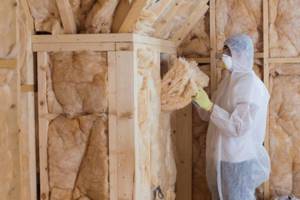
Necessary tools and materials for work
There are several ways to insulate walls, which we will consider below. But there is a certain set of materials and tools that will be useful in almost any case:
- roulette;
- building level;
- screwdriver;
- self-tapping screws, screws, nails;
- metallized tape;
- waterproofing membrane;
- wooden slats;
- dowels;
- knives;
- primer;
- and, of course, the mineral wool itself.
Instead of wooden slats, it is permissible to use metal profiles. In addition, do not forget to protect your health: prepare a respirator, gloves, special glasses or a full-fledged protective suit.
Tips and tricks
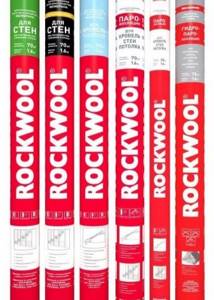
Thus, for wall insulation (Lite and Scandic) a diffuse vapor-permeable membrane is provided in regular and fire-retardant-treated versions. Special Rockwool vapor barrier is used to insulate roofs and ceilings.
When organizing a “wet” facade, you will need a special water-dispersed primer “Rockforce”, as well as “Rockglue” glue and “Rockmortar” adhesive to create a reinforcing layer. It is recommended to apply the final primer over the reinforcing layer using the Rockprimer KR mixture. As a decorative mixture, you can use the branded products “Rockdecor” (plaster) and “Rocksil” (silicone paint for facades).
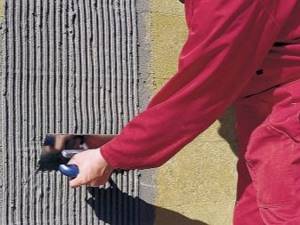
To learn how to insulate a house yourself using Rockwool materials, see below.
Technology and methods of wall insulation
Having chosen the desired thickness and other properties of mineral wool for wall insulation, it’s time to move on to choosing a fastening method. When it comes to exterior work, there are three main methods to do this: the well system, the wet method and the ventilated façade.
The first point implies the following design: mineral wool is laid between bricks (or other building materials) inside the wall. A ventilated facade is an option for wooden houses, when a frame is erected around the perimeter of the building, and mineral wool is tightly laid inside it. Attaching mineral wool to the wall is easy; it requires either plastic dowels or an adhesive.
As for the wet method, the slabs should be fixed directly on the surface of the wall, and not inside it. Let's consider this option in more detail.
Mineral wool in slabs

Perhaps slabs are the most popular mineral wool product. They usually come in standard sizes. The slabs are always produced in a rectangular shape, their length varies in the range of 100-600 cm, and their width in the range of 20-180 cm. The thickness of the mineral wool in this case can be 1-25 cm. This range was achieved thanks to the production technology itself. In this case, the mineral wool fibers are well compressed and joined not with resins, but with synthetic glue. They are often impregnated with a hydrophobic compound or mineral oil, this protects them from moisture.
Thin slabs can only be used where they are not subject to significant loads. That is, for unused attic spaces, you can choose thinner slabs. They can also be used to insulate internal partitions, suspended ceilings and wooden floors. From a technical point of view. characteristics, mineral wool can be used for outdoor work. But in practice, it is easy to install only in houses built using frame technology or with three-layer brick walls.
The thickness of mineral wool for attic insulation should be at least 20, or even 25 cm. In general, such dense and thick slabs are highly durable, so they can be used not only for thermal insulation of the attic, but also where the loads will be even higher. For example, this could be insulation of floors built on the ground, insulation of a flat roof (mineral wool can be laid directly under roofing felt). In addition, such slabs can be used for thermal insulation of facades under plaster (that is, where the wet method is used).
Now let’s calculate the thickness for each city:
External wall insulation
The procedure for the wet method is as follows:
- Clean the surface, get rid of all depressions and irregularities.
- Secure the basement cornice.
- Glue mineral wool with a special compound.
- For additional security, secure it with dowels.
- Apply reinforcing mesh.
- Prime the surface thoroughly.
- Plaster it.
- Finally, paint it any color you like.
If this option is not suitable and you are inclined to classic insulation, then build a ventilated facade according to our instructions:
- Saturate the wall with an antiseptic composition. If you notice rot, it also needs to be treated with a special solution.
- Remove slopes and/or trims.
- Dry the walls for at least 24 hours.
- Lay a layer of membrane with high vapor permeability so that the smooth side is in contact with the mineral wool. The membrane does not need to be used if the wall is perfectly flat.
- Using self-tapping screws, secure the wooden slats to the wall; their thickness should be equal to the thickness of the insulation, and the distance between them should be 2 cm less than the width of the mineral wool slab.
- Place the insulation material into the resulting sheathing.
- The next layer is material for protection from wind and water. You can attach it with a stapler.
- To form a ventilated gap, counter battens are also nailed on top of the sheathing - the facing material should be at a distance of 6 cm from the insulation.
At the end, install new platbands and slopes (the old ones will not fit because the thickness of the walls has increased).

Selection of insulation material
When choosing a material for insulating the walls of a house, it is necessary to compare several options to ensure the most comfortable temperature conditions inside the building and save money on work and materials.
| Material | Foam plastic (expanded polystyrene) | Polyurethane foam | Basalt wool | Ecowool | Glass wool |
| Release form | Regular slabs, extruded | Spraying (foam mass) | Plates, mats | Scattering, spraying | Plates, rolls |
| Thermal conductivity coefficient depending on density | 0,030…0,050 | 0,041…0,020 | 0,032…0,050 | 0,037 | 0,042…0,07 |
| Installation method | On disc dowels, on glue | Spraying from a cylinder, requires limiters (open or closed cells) | Fastening with disc dowels, strips | In bulk, spraying on surfaces of any geometry. In the bulk method, it is placed between layers of building materials. | Disc dowels, special fasteners |
| Required surface finish (protection) | Plaster | Plaster, decorative cladding | Steam and waterproofing, any facade finishing | Mandatory sheathing or rough wall for exterior finishing | Under hard cladding (lathing, rough wall) |
| Water permeability, vapor permeability | Absent | Absent | Hygroscopic, loses properties when humidity increases | Hygroscopic, does not change thermal conductivity up to 20% humidity by volume | Hygroscopic, loses properties when moistened |
| Fire safety | Flammable, emits smoke, permissible temperature up to 75 degrees Celsius | Low flammability, does not emit harmful substances | Non-flammable, maximum temperature up to 600...700 degrees Celsius | Does not burn, makes it difficult for fire to spread | Non-flammable, does not emit harmful substances |
| Noise insulation | Low | High | Medium, high (depending on density) | High | High, medium (depending on density and construction method) |
| Application area | Inclined, vertical and horizontal flat surfaces. Ideal for plinths and basements | Surfaces with any geometry, preferably horizontal and inclined | External thermal insulation of facades, roofs, surfaces with simple geometry | Any structures, including complex geometries, inside and outside the building | Any designs of simple geometry |
Table. Comparative characteristics of heat-insulating materials
It should be noted that when deciding how to insulate the walls of a house from the outside, it is worth taking into account the emergence of new materials with higher performance characteristics. However, upon purchase, the manufacturer is obliged to provide certificates of material conformity, test results, and give the opportunity to check the properties of the insulator. One of the simplest ways to check is to weigh a cubic meter of material adjusted for packaging, since it is the density that unscrupulous manufacturers indicate with deliberate inaccuracy. For comparison and financial calculations, you can use the data in the following table.
The choice of material should also be based on cost. Depending on the thickness of the layer and thermal insulation ability, the final cost of insulating the outside of a wooden house with a more expensive material may be less than a cheaper one. For comparison, the data is presented below.
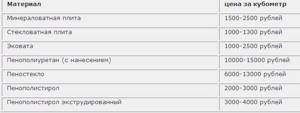
Table. Comparative cost of a cubic meter of heat-insulating material (Moscow, end of 2021).
Selection of insulating material taking into account the cost of work
Before you finally decide how to insulate the house outside, it is also important to find out the cost of the work. If they are carried out independently, the cost of fastening and preparing the walls (roof, under-roof structures, foundation, etc.) for installation is taken into account
If professional installation is preferred, you should find out the prices of the selected company in advance.
How to insulate outside walls:
- depending on the type of main wall, choose the method of fastening - using an adhesive (adhesive-cement, cement) composition, using disc-shaped dowels, other fasteners, spraying;
- prepare the wall for installation (cleaning the façade finishing - if necessary), level the surface if there are significant protrusions;
- carry out installation;
- perform surface finishing. This could be laying out an additional layer of facing brick, decorating the facade with siding or clapboard, sealing it with plaster or facade tiles, installing a ventilated facade, and so on.
Calculate the insulation of your home
The required amount of mineral wool is not selected at random, but taking into account the weather conditions of a particular region.
In the Moscow and Leningrad regions, for example, the climate is temperate and continental. Here it is recommended to insulate the house with mineral wool slabs with a thickness of 8 to 10 cm. The further north you are from these places, the greater this figure will be. In the Murmansk region, the optimal thickness of wool for wall insulation will be about 15 cm.
A material whose density is less than 40 kg/cubic meter is used exclusively on horizontal surfaces that are not subject to load (this is the kind of mineral wool that is usually produced in the form of rolls).
For insulation of external walls, the density is in the range of 50–75, and for creating a ventilated facade - all 110, and even more if the surface is still covered with plaster.
Choosing the optimal thickness of mineral wool for walls, roofs and other structures
There is a large selection of mineral wool on store shelves depending on parameters, thickness, and manufacturer. How to choose the right size?
The choice is made at the design stage of the house. First of all, the structure that needs to be insulated is taken into account. One type of mineral wool is used for walls, and models with other parameters are used for floors, roofs, and attic floors.
With the right mineral wool, you can retain maximum heat in your home. It will not pass through the walls, first floor floor or roof.
Important! According to professionals, complete insulation of the roof is important. If mineral wool is present only in the attic, then about 20% of the heat leaves this part of the house. Therefore, it is necessary to use thermal insulation material in the roof itself.
It is up to the specialist to select the optimal thickness. To do this, he takes a special formula, based on two important parameters: thermal conductivity coefficient and heat transfer resistance of external walls. The first indicator is measured in W/m*K, and is denoted by a combination of letters λB. There is no need to calculate this characteristic, since it is indicated on the packaging. The best thermal insulation properties are those that have the lowest thermal conductivity coefficient.
The second parameter (heat transfer resistance) is indicated by the letter R. It is influenced by the climate where it is planned to build the house. It is measured in m2*0С/W.
You can get a more accurate indicator of the optimal thickness by focusing on SNiP data, which will take into account the climate, humidity of a particular area and other important indicators.
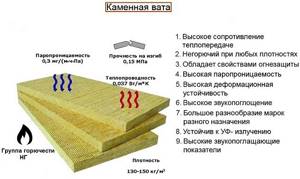
The climatic zone of the area where the house is being built primarily influences the choice of thickness. If low temperatures prevail in winter with a long heating period, it is better to choose the greatest thickness of insulation. But at the same time, this parameter can be reduced when insulating wooden walls or foam blocks. Such materials have lower thermal conductivity compared to reinforced concrete and brick.
Important! When calculating the thickness of insulation for a frame house, use the formula - αут=(R-0.16)*λB.
